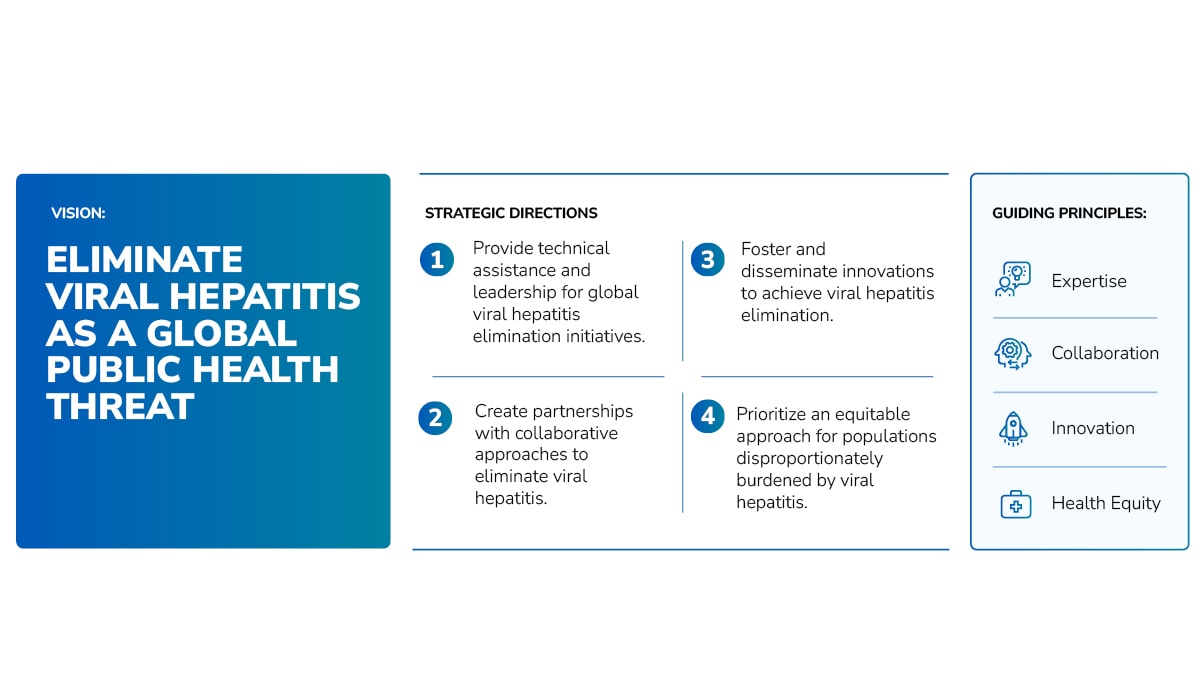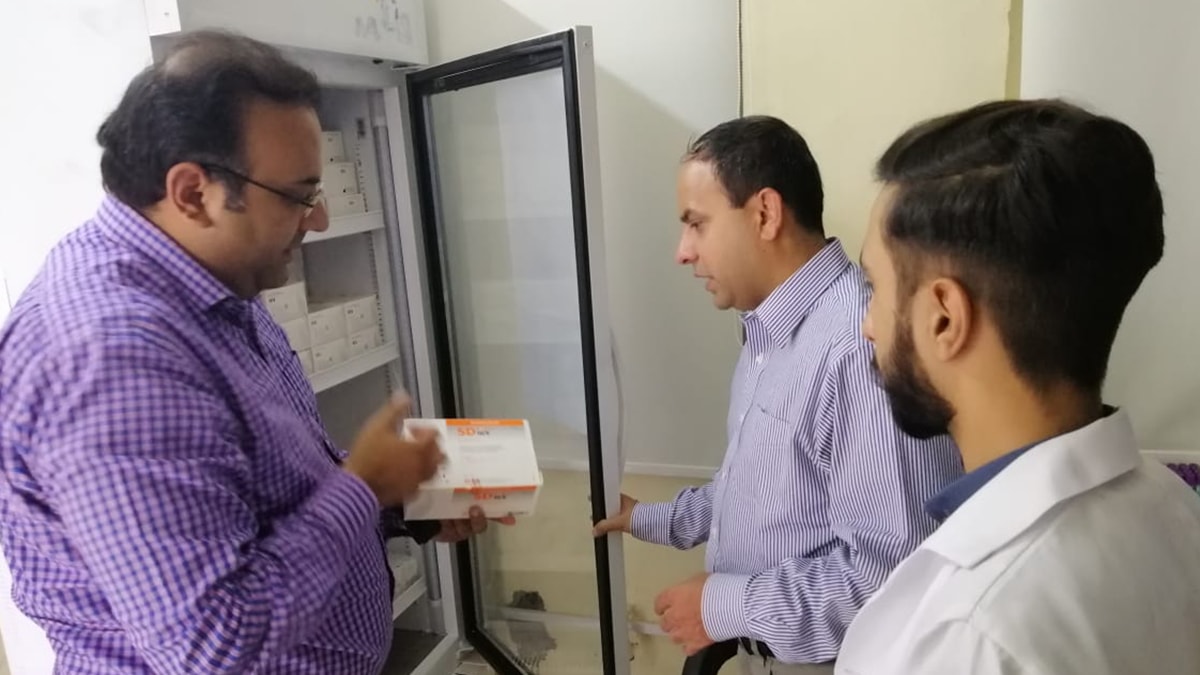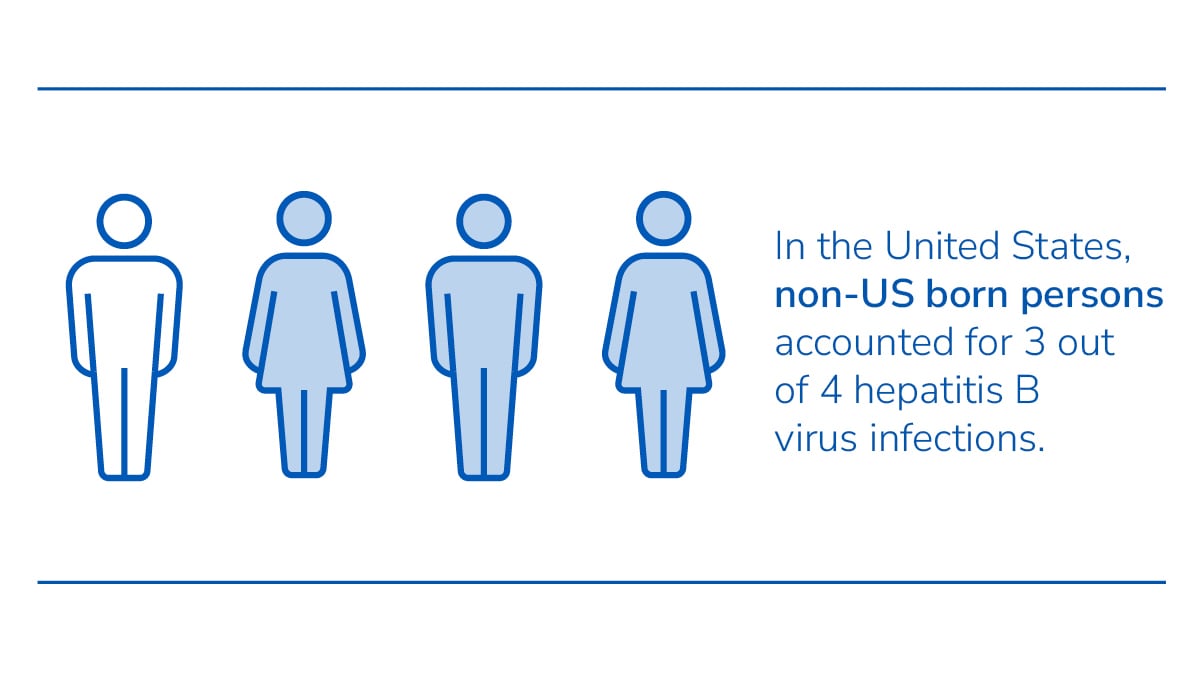At a glance
CDC works with international partners and other countries to prevent, control, and eliminate viral hepatitis as a global public health threat.

CDC efforts to eliminate viral hepatitis globally
CDC provides external programmatic support, technical assistance, and strategic leadership to countries and organizations working toward global viral hepatitis elimination.

Vision: CDC's overall vision is to eliminate viral hepatitis as a global public health threat.
Strategic directions: CDC has four key strategic directions building toward our vision.
- Provide technical assistance and leadership for global viral hepatitis elimination initiatives.
- Create sustainable partnerships with collaborative approaches to eliminate viral hepatitis.
- Foster and disseminate innovations to achieve viral hepatitis elimination.
- Prioritize an equitable approach for populations disproportionately burdened by viral hepatitis.
Guiding principles: CDC is guided by the following principles.
- Expertise
- Collaboration
- Innovation
- Health equity
CDC's focus areas in global viral hepatitis are both global and country-specific.
Global guidance
As a WHO Collaborating Center for Reference and Research on Viral Hepatitis, CDC is a key partner in the development and review of WHO guidance on viral hepatitis, such as:
- Guidance for country validation of viral hepatitis elimination and path to elimination.
- Global guidance on criteria and processes for validation: elimination of mother-to-child transmission of HIV, syphilis, and hepatitis B virus (HBV).
- Updated recommendations on treatment of adolescents and children with chronic hepatitis C virus (HCV) infection, and hepatitis C simplified service delivery and diagnosis.
- Guidelines for the care and treatment of people diagnosed with chronic HCV infection.
- Guidelines on person-centered viral hepatitis strategic information using data to support country scale-up of hepatitis prevention, diagnosis, and treatment services.
- Updated guidelines for the prevention, diagnosis, care and treatment for people with chronic hepatitis B
- Operational guide for planning person-centered hepatitis B and hepatitis C testing services
Country-specific guidance
CDC also supports other countries as they:
- Review and evaluate their existing viral hepatitis activities and programs.
- Develop their national viral hepatitis strategic plans.
Burden estimates
CDC works with international partners to estimate the burden of viral hepatitis in other countries. This information is critical to inform national policies and to set valid elimination goals.
CDC also supports countries as they work to:
- Design and implement nationally representative serosurveys to measure progress and identify gaps in progress.
- Assess viral hepatitis disease burden in key populations to inform prevention, care, and treatment needs.
- Implement economic assessments to prioritize activities with largest impact.
- Evaluate the impact of current investments in preventing disease and death.
CDC also participates in global and regional verification commissions to review country reports and track elimination progress.
Prevention, diagnosis, and treatment
CDC supports countries working to scale up prevention, diagnosis, and treatment. Specific goals are to:
- Implement innovative funding approaches and interventions to increase testing and treatment in low- and middle-income countries.
- Evaluate hepatitis C self-testing methods to scale up diagnosis and treatment among key and general populations.
- Implement interventions to improve hepatitis B and hepatitis C prevention, testing, and treatment among the general population and persons at risk of infection.
- Strengthen laboratory capacity to improve diagnostic capacity for viral hepatitis in countries CDC supports.

International collaboration is important
In the United States, people not born in the US account for 3 out of 4 HBV infections. 1

These collaborations:
- Help the host country reduce disease and death.
- Reduce the likelihood that people coming to the US are infected.
- Help reduce the risk for disease among US travelers abroad.
Success story
CDC has provided technical and financial assistance to the country of Georgia to advance viral hepatitis elimination for nearly a decade.
To learn more about how CDC is working in the country of Georgia, see Advancing Viral Hepatitis Elimination in Georgia.
- Bixler D, Barker L, Lewis K, Peretz L, Teshale E. Prevalence and awareness of Hepatitis B virus infection in the United States: January 2017–March 2020. Hepatol Commun. March 30, 2023;7(4):e0118.
- World Health Organization. Global health sector strategy on viral hepatitis 2016–2021. Towards ending viral hepatitis. May 17, 2016.
- * Elimination is defined as a 90% reduction in incidence and 65% reduction in mortality by 2030, compared with the 2015 baseline.2
